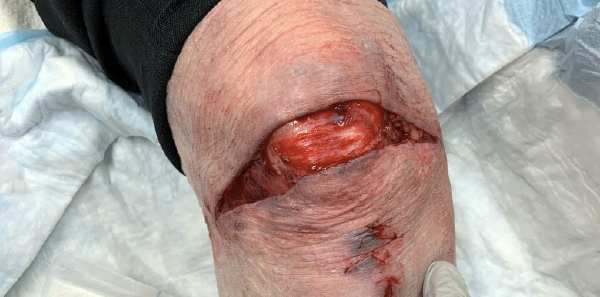
How Well Does SLT Perform?
How well does this test perform in diagnosing traumatic knee arthrotomy? In 1996, Voit et al compared SLT to clinical judgment alone in 50 patients with periarticular traumatic wounds of the knee.4 The study found clinical judgment alone had a sensitivity of 57 percent and a specificity of 61 percent when using SLT as the gold-standard test. SLT changed management in 40 percent of patients, and the authors concluded that SLT is superior to clinical judgment alone. However, the authors did not consider the possibility of false-positive and false-negative SLT results.
Explore This Issue
ACEP Now: Vol 39 – No 04 – April 2020Several subsequent studies evaluated the sensitivity of SLT in patients undergoing elective knee arthroscopy.2,5-8 The sensitivity of SLT in these studies varied considerably, ranging from 36 to 99 percent, owing to differences in SLT technique such as the amount of saline injected, the size of the surgical incision, the position of the knee, and whether the knee was moved through its range of motion. Other patient-specific factors, such as age, sex, and body mass index, also may have played a role. Regardless, it is difficult to apply the results of these studies of elective arthroscopic knee surgery patients to patients presenting to the emergency department with traumatic knee injuries.
In 2013, Konda et al used a novel approach to study SLT in 50 patients presenting to the emergency department with periarticular knee wounds.9 In this study, all patients underwent SLT, and those with positive results went to the OR for arthroscopy to confirm the presence or absence of a traumatic knee arthrotomy. Patients with a negative SLT and no other indications for operative management were discharged and monitored for septic arthritis at follow-up. Those who subsequently developed septic arthritis were considered to have a missed traumatic knee arthrotomy. How well did SLT perform in this study? The authors found a sensitivity of 94 percent and a specificity of 91 percent using this approach. Given the prevalence of traumatic knee arthrotomy in this study, the false-positive rate was 16 percent and the false-negative rate was 3 percent. This false-negative rate was attributed to a single patient who had a negative SLT but went to the OR for a grossly contaminated wound and was found to have a traumatic knee arthrotomy. The authors note that none of the patients discharged after a negative SLT went on to develop septic arthritis; however, the study was underpowered to adequately detect infection in this population.
Pages: 1 2 3 4 | Single Page



One Response to “Saline Load or CT: What’s the Best Test for Traumatic Arthrotomy?”
April 26, 2020
Joel Pasternack, MD, PhD, FACEPGood Article by Dr. Strong.
Clinical judgement can be enhanced as follows: Explore and irrigate wound through full range of motion. Obtain cross table lateral x-ray looking for air under the patella or in supra patella recess, after irrigation. The irrigation process will make the x-ray more sensitive for air without decreasing specificity. Gentle syringe irrigation will force more air into joint than may have entered from original injury.